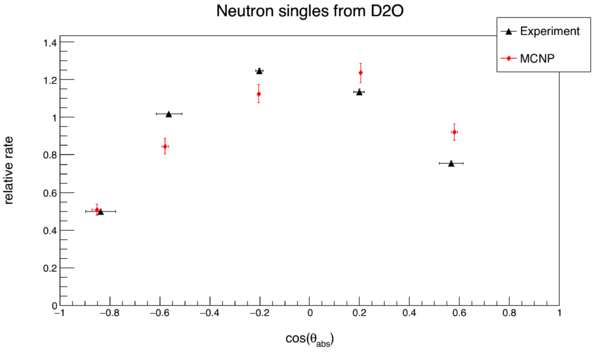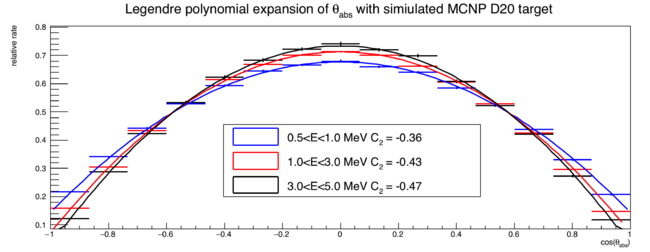Difference between revisions of "JB Absolute theta"
| Line 3: | Line 3: | ||
== Overview== | == Overview== | ||
Here I use neutron single events to measure the distribution of theta_abs, or the angle between an incident photon and a resultaning photo-neutron. | Here I use neutron single events to measure the distribution of theta_abs, or the angle between an incident photon and a resultaning photo-neutron. | ||
| + | The distribution of uncorrelated neutrons from the SF of californium 252 is used to "divide out" the effects of detector geometry, efficiency, drifts, ect. | ||
For D2O, the result is compared to an MCNP simulation which was built to model as many aspects of the experiment as possible. | For D2O, the result is compared to an MCNP simulation which was built to model as many aspects of the experiment as possible. | ||
Revision as of 07:09, 9 November 2017
Overview
Here I use neutron single events to measure the distribution of theta_abs, or the angle between an incident photon and a resultaning photo-neutron. The distribution of uncorrelated neutrons from the SF of californium 252 is used to "divide out" the effects of detector geometry, efficiency, drifts, ect. For D2O, the result is compared to an MCNP simulation which was built to model as many aspects of the experiment as possible.
Beam
I performed an MCNP simulation of a D2O target subject to an 10.5 MeV end-point bremsstrahlung beam. A mock-up of our entire neutron detector array is included in the simulation. Detector physics is modeled by applying a detection threshold in terms of light output (MeVee), which is equal to the typical MeVee produced by 0.5 MeV neutrons within the scintillator.
A Cf252 source was also simulated, allowing me to apply the exact same analysis technique to simulation and experimental data .
MCNP-POLIMI
Below is an MCNP-POLIMI simulation of a cylindrical D20 target (axis length = 2"; dia. = 0.75") subject to a bremsstrahlung photon beam with an end point of 10.5MeV. The plot below shows the relative distribution of neutron direction cosines w.r.t. the incident photon beam. All neutrons are from the photodisintegration of D20 and the direction cosine is taken as neutrons exit the target geometry.

